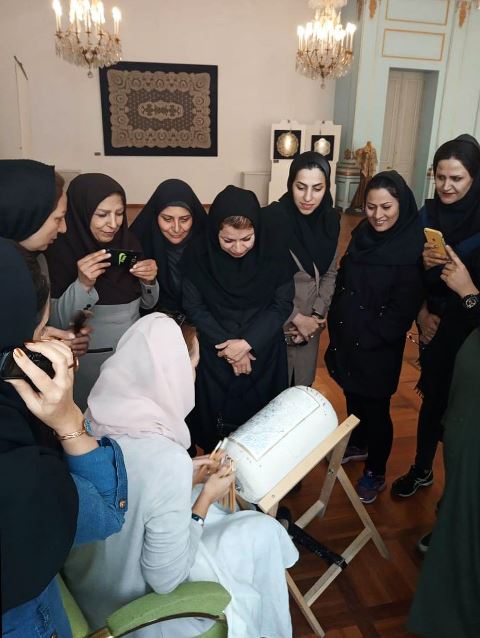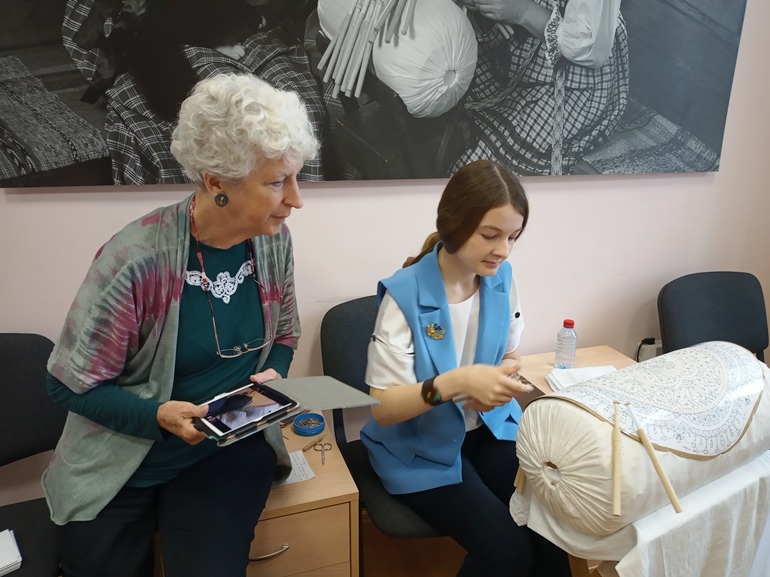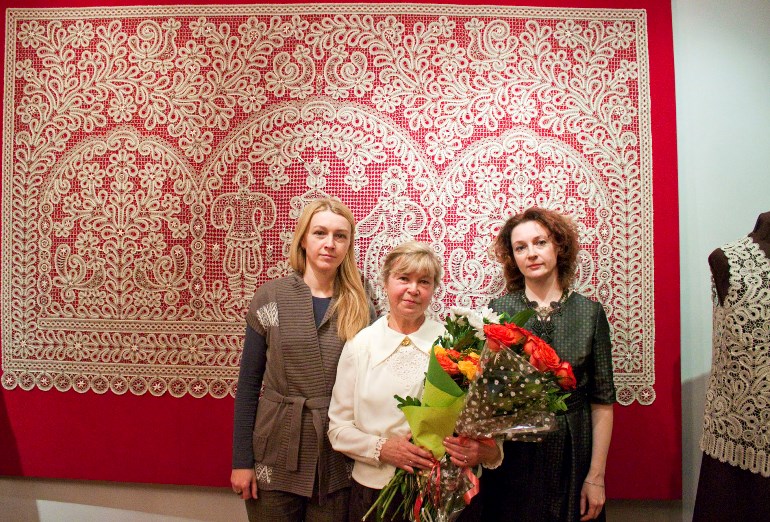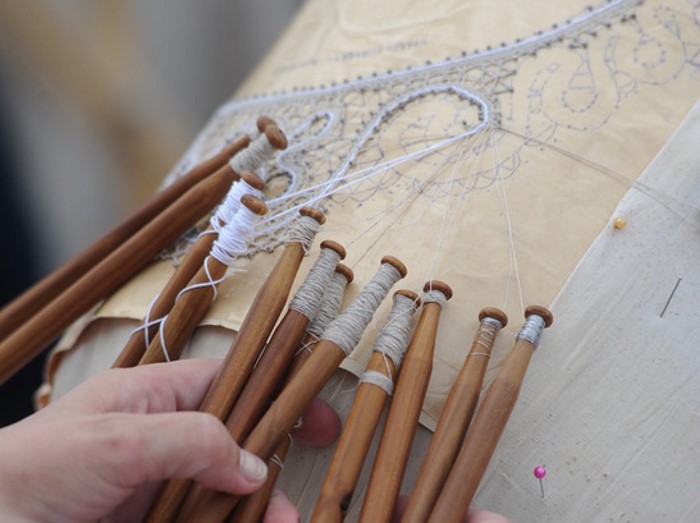
In the parlance of Vologda lace
/ Главная / Russkiy Mir Foundation / Publications / In the parlance of Vologda laceIn the parlance of Vologda lace
Sergey Vinogradov
Over the 10 years since its establishment, the Vologda Lace Museum has become one of the world centers of lacemaking. In the past year, the Museum opened an exhibition and gave a master class in Iran, trained lacemakers from the USA and Estonia, exhibited and accepted unique Maltese lace as a gift, as well as participated in other international projects. In the summer of 2020, Vologda will host the Vita Lace, an international lace festival, which will bring together the creme de la creme of global lace community from Finland to Australia.
Artisans, who had made Vologda lace famous worldwide 40+ years ago, shared with the Russkiy Mir that delighted foreigners asked, in general, two questions: “How do you make it?” and “How can we become your students?”

Vologda lacemakers. Photo credit: booksite.ru
“Ready to learn through Skype”
The Vologda Lace Museum was originally intended to be the global lace center. The museum exhibition opens with a detailed story on history of lace-making in Europe (with display of exhibits, of course). The Vologda Museum has always welcomed a lot of foreign tourists, who sometimes learn there traditions of lace-making in their own countries (such as Germany and France, Spain and Poland) from the 17th century to the present day.
The Museum maintains close contact with museums, centers, associations and co-operative craft societies of Switzerland, the Czech Republic, Slovakia, Croatia, Denmark, Finland, Estonia, Australia and other countries. They conduct joint workshops and exhibitions, as well as visit each other for learning. In recent years, Vologda hosted exhibitions of traditional Danish lace, and in 2020 the Museum will host an exhibition of Slovenian lacemakers. Vologda exhibitions have been travelling across Europe for a few years now.
– We have been developing very good cooperation with foreign colleagues, mainly with European centers, Natalia Boeva, the head of the museum, said to the Russkiy Mir. – Opening of the exhibition of Maltese lace of various centuries was an important event for our museum this year. Those works are very rare, and we in Russia know little about lacemaking technique of Malta. It was very nice to receive part of the works as a gift.
Vologda lace came to Iran as part of the Russian Culture Days in Tehran. Vologda residents brought unique exhibits that have repeatedly appeared on the covers of Russian and international booklets and magazines. Also, the delegation included artisans who came to Iran and gave master classes for local craftswomen. Photos of Vologda lacemakers surrounded by women in hijabs admiringly watching the bobbins and hands of the artisans were published on front pages of the Vologda media.

Vologda Lace Exhibition in Iran. Photo credit: cultinfo.ru
– That meeting was a unique experience for us, I think, for Tehran too, says Natalia Boeva. - We have already visited so many places in Europe, and many Europeans do not see the lace-making technique as something surprising, since it can be found in many countries. As to the Middle East, and specifically to Iran, the lace-making technique is something unconventional and indistinctive. At the same time, Iranians have reverent attitude for crafts and any handmade work. They have many crafts of their own - the famous Persian carpets, tile murals. They are great artisans. When they saw how Vologda lacemakers create such beauty in front of the audience, there was no limit to the delight and amazement. Many people came up to us and asked how and where they could learn lacemaking, some of them were even ready to take lessons through Skype. I think Iranian women have the world before them.
In May, the Lace Museum welcomed a large group of lacemakers from Estonia. They asked their Vologda colleagues to clarify some of technical aspects of Vologda lace. Vologda artisans responded to the request and conducted a theoretical and practical workshop. During the workshop, the guests were able to make a simple bird in accordance with the Vologda traditions.
Recently, the Museum welcomed Katherine Dunleway, an American colleague who works for the Cleveland Museum of Art and is an expert in fabrics and textiles. “She contacted us and said that their museum received a collection of lace, and some exhibits were identified as supposedly of Vologda origin,” says Natalia. “The American asked if it was possible to work with our holdings, and we invited her for a visit. We receive such requests from colleagues from various countries quite often. We gave a master class for Katherine Dunleway, as she herself makes lace. Our communication was very informative.”

Katherine Dunleway is learning to make Vologda lace. Photo courtesy of the Lace Museum (Vologda)
“They came up with a magnifying glass and examined works”
There is kind of “Mona Lisa” among thousands of lace canvas made by Vologda artisans. The lacy bird has become a symbol of the craft, as well as of the entire Vologda Territory. Angelina Rakcheeva, the bird’s author, has dedicated 40 years to the art of lace. Today she shares her skills and experience with young artisans.
Angelina Nikolaevna’s works have been exhibited in the Louvre and other topline galleries of the world. She opened Vologda lace exhibitions in Finland, Austria, Yugoslavia, India, Holland and other countries.
Vologda lace with its unique technique thundered throughout Europe almost a hundred years ago – back then, in 1925, the works of the artisans won the gold medal at the International Exhibition in Paris. Then there was the second victory in Paris and the triumph in Brussels - "Russian Motives", the Vologda lace canvas, was awarded the Grand Prix of the international exhibition.
But the actual global expansion by Vologda lace began in the 1970s and 1980s, and Angelina Rakcheeva stood at the origins of this world conquest by lace.
– My very first foreign exhibition was in Austria in 1980, she told the Russkiy Mir. - There I spoke about our lacemaking work, talked about exhibits, and conducted tours. I recall that the exhibition sparked furore. It was an international event, but mostly visitors came to our displays. Foreigners were surprised that our lace is so thin, and the works are so huge. And that everything is hand-made. Experts came up with a magnifying glass and examined works.

Angelina Rakcheeva shares art and skills with her daughters - Eugenia and Julia (at the photo). Photo credit: cultinfo.ru
The echoes of that exhibition in Vologda were experienced for more than one year – there was feedback received in different languages, as well as questions, and requests. And many years later, foreign tourists came to Angelina Rakcheeva and said: "I saw your work in Austria."
According to the artisan, the exhibition conducted in Finland in 1984 was the most memorable event in her life. “In early July the annual lace festival is held In the Finnish city of Rauma, and I was also impressed with the lacemaker sculpture installed there,” says Angelina Rakcheeva. “And during the festive week, guests lay garlands of flowers at it. It would be nice to install a similar one in Vologda.”
The Vologda lacemakers’ art again received the highest appraisal of experts in Finland. And once more they emphasized the skill and fineness of the work, as well as the huge size of the Vologda canvases. “Our art is the team work, while in Europe it is mostly made individually,” says the artisan. “That is why the size is so big.” There is another secret of Russian lace: it is made by certified artists in Vologda, as well as in other cities. However, foreign craftswomen make lace in their off-duty time.
Without any language barrier
Many of them asked Vologda craftswomen to share their artfulness, and some friendly relationship established there lasted for decades. “I communicated with Leah, a lacemaker from the Dutch city of Zwolle for many years,” she says. “She dreamed of coming to the Soviet Union, to Vologda - to see, and to learn.” The language barrier miraculously disappeared when women sat next to each other and took up the bobbins.

Those very bobbins. Photo by the author
Such language is understood by thousands of craftswomen (and there are also many craftsmen in the lacemaking community) around the world. Vologda is preparing for a large international lace forum this summer. During the previous one, there was a challenge to accommodate all guests in the central Kremlin square of the city.
New publications

 Mikhail Kalatozov, a director who transformed the world of cinematography in many ways, was born 120 years ago. He was a Soviet film official and a propagandist. Above all, he was capable of producing movies that struck viewers with their power and poetic language.
Mikhail Kalatozov, a director who transformed the world of cinematography in many ways, was born 120 years ago. He was a Soviet film official and a propagandist. Above all, he was capable of producing movies that struck viewers with their power and poetic language.  Ukrainian authorities have launched a persecution campaign against the canonical Ukrainian Orthodox Church (UOC), the biggest one in the country's modern history. Over the past year, state sanctions were imposed on clergy representatives, searches were conducted in churches, clergymen were arrested, criminal cases were initiated, the activity of the UOC was banned in various regions of the country, and monasteries and churches were seized.
Ukrainian authorities have launched a persecution campaign against the canonical Ukrainian Orthodox Church (UOC), the biggest one in the country's modern history. Over the past year, state sanctions were imposed on clergy representatives, searches were conducted in churches, clergymen were arrested, criminal cases were initiated, the activity of the UOC was banned in various regions of the country, and monasteries and churches were seized.  When Nektary Kotlyaroff, a fourth-generation Russian Australian and founder of the Russian Orthodox Choir in Sydney, first visited Russia, the first person he spoke to was a cab driver at the airport. Having heard that Nektariy's ancestors left Russia more than 100 years ago, the driver was astonished, "How come you haven't forgotten the Russian language?" Nektary Kotlyaroff repeated his answer in an interview with the Russkiy Mir. His affinity to the Orthodox Church (many of his ancestors and relatives were priests) and the traditions of a large Russian family brought from Russia helped him to preserve the Russian language.
When Nektary Kotlyaroff, a fourth-generation Russian Australian and founder of the Russian Orthodox Choir in Sydney, first visited Russia, the first person he spoke to was a cab driver at the airport. Having heard that Nektariy's ancestors left Russia more than 100 years ago, the driver was astonished, "How come you haven't forgotten the Russian language?" Nektary Kotlyaroff repeated his answer in an interview with the Russkiy Mir. His affinity to the Orthodox Church (many of his ancestors and relatives were priests) and the traditions of a large Russian family brought from Russia helped him to preserve the Russian language.

 The leaders of the Friends of the Great Russia cultural association (Amici Della Grande Russia) in Italy believe that the Western policy of abolishing Russian culture in Europe has finally failed. Furthermore, it was doomed to failure from the beginning.
The leaders of the Friends of the Great Russia cultural association (Amici Della Grande Russia) in Italy believe that the Western policy of abolishing Russian culture in Europe has finally failed. Furthermore, it was doomed to failure from the beginning.  Name of Vladimir Nemirovich-Danchenko is inscribed in the history of Russian theater along with Konstantin Stanislavski, the other founding father of the Moscow Art Theater. Nevertheless, Mr. Nemirovich-Danchenko was a renowned writer, playwright, and theater teacher even before their famous meeting in the Slavic Bazaar restaurant. Furthermore, it was Mr. Nemirovich-Danchenko who came up with the idea of establishing a new "people's" theater believing that the theater could become a "department of public education."
Name of Vladimir Nemirovich-Danchenko is inscribed in the history of Russian theater along with Konstantin Stanislavski, the other founding father of the Moscow Art Theater. Nevertheless, Mr. Nemirovich-Danchenko was a renowned writer, playwright, and theater teacher even before their famous meeting in the Slavic Bazaar restaurant. Furthermore, it was Mr. Nemirovich-Danchenko who came up with the idea of establishing a new "people's" theater believing that the theater could become a "department of public education."  "Russia is a thing of which the intellect cannot conceive..." by Fyodor Tyutchev are famous among Russians at least. December marks the 220th anniversary of the poet's birth. Yet, he never considered poetry to be his life's mission and was preoccupied with matters of a global scale. Mr.Tyutchev fought his war focusing on relations between Russia and the West, the origins of mutual misunderstanding, and the origins of Russophobia. When you read his works today, it feels as though he saw things coming in a crystal ball...
"Russia is a thing of which the intellect cannot conceive..." by Fyodor Tyutchev are famous among Russians at least. December marks the 220th anniversary of the poet's birth. Yet, he never considered poetry to be his life's mission and was preoccupied with matters of a global scale. Mr.Tyutchev fought his war focusing on relations between Russia and the West, the origins of mutual misunderstanding, and the origins of Russophobia. When you read his works today, it feels as though he saw things coming in a crystal ball...